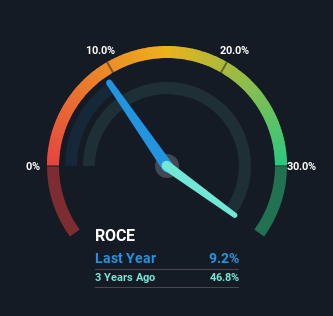Jiangsu Boiln Plastics (SZSE:301003) Might Be Having Difficulty Using Its Capital Effectively

If we want to find a stock that could multiply over the long term, what are the underlying trends we should look for? In a perfect world, we'd like to see a company investing more capital into its business and ideally the returns earned from that capital are also increasing. This shows us that it's a compounding machine, able to continually reinvest its earnings back into the business and generate higher returns. However, after investigating Jiangsu Boiln Plastics (SZSE:301003), we don't think it's current trends fit the mold of a multi-bagger.
Understanding Return On Capital Employed (ROCE)
For those who don't know, ROCE is a measure of a company's yearly pre-tax profit (its return), relative to the capital employed in the business. Analysts use this formula to calculate it for Jiangsu Boiln Plastics:
Return on Capital Employed = Earnings Before Interest and Tax (EBIT) ÷ (Total Assets - Current Liabilities)
0.092 = CN¥109m ÷ (CN¥1.2b - CN¥44m) (Based on the trailing twelve months to December 2023).
Therefore, Jiangsu Boiln Plastics has an ROCE of 9.2%. On its own that's a low return, but compared to the average of 5.8% generated by the Chemicals industry, it's much better.
See our latest analysis for Jiangsu Boiln Plastics

Historical performance is a great place to start when researching a stock so above you can see the gauge for Jiangsu Boiln Plastics' ROCE against it's prior returns. If you're interested in investigating Jiangsu Boiln Plastics' past further, check out this free graph covering Jiangsu Boiln Plastics' past earnings, revenue and cash flow.
What Does the ROCE Trend For Jiangsu Boiln Plastics Tell Us?
In terms of Jiangsu Boiln Plastics' historical ROCE movements, the trend isn't fantastic. Over the last five years, returns on capital have decreased to 9.2% from 38% five years ago. However it looks like Jiangsu Boiln Plastics might be reinvesting for long term growth because while capital employed has increased, the company's sales haven't changed much in the last 12 months. It may take some time before the company starts to see any change in earnings from these investments.
On a side note, Jiangsu Boiln Plastics has done well to pay down its current liabilities to 3.5% of total assets. So we could link some of this to the decrease in ROCE. What's more, this can reduce some aspects of risk to the business because now the company's suppliers or short-term creditors are funding less of its operations. Some would claim this reduces the business' efficiency at generating ROCE since it is now funding more of the operations with its own money.
The Bottom Line
In summary, Jiangsu Boiln Plastics is reinvesting funds back into the business for growth but unfortunately it looks like sales haven't increased much just yet. And with the stock having returned a mere 1.4% in the last year to shareholders, you could argue that they're aware of these lackluster trends. So if you're looking for a multi-bagger, the underlying trends indicate you may have better chances elsewhere.
One final note, you should learn about the 2 warning signs we've spotted with Jiangsu Boiln Plastics (including 1 which is a bit concerning) .
If you want to search for solid companies with great earnings, check out this free list of companies with good balance sheets and impressive returns on equity.
If you're looking to trade Jiangsu Boiln Plastics, open an account with the lowest-cost platform trusted by professionals, Interactive Brokers.
With clients in over 200 countries and territories, and access to 160 markets, IBKR lets you trade stocks, options, futures, forex, bonds and funds from a single integrated account.
Enjoy no hidden fees, no account minimums, and FX conversion rates as low as 0.03%, far better than what most brokers offer.
Sponsored ContentNew: Manage All Your Stock Portfolios in One Place
We've created the ultimate portfolio companion for stock investors, and it's free.
• Connect an unlimited number of Portfolios and see your total in one currency
• Be alerted to new Warning Signs or Risks via email or mobile
• Track the Fair Value of your stocks
Have feedback on this article? Concerned about the content? Get in touch with us directly. Alternatively, email editorial-team (at) simplywallst.com.
This article by Simply Wall St is general in nature. We provide commentary based on historical data and analyst forecasts only using an unbiased methodology and our articles are not intended to be financial advice. It does not constitute a recommendation to buy or sell any stock, and does not take account of your objectives, or your financial situation. We aim to bring you long-term focused analysis driven by fundamental data. Note that our analysis may not factor in the latest price-sensitive company announcements or qualitative material. Simply Wall St has no position in any stocks mentioned.
About SZSE:301003
Jiangsu Boiln Plastics
Researches and develops, produces, and sells modified plastic products in China, Hong Kong, Taiwan, Southeast Asia, North America, South America, and Europe.
Flawless balance sheet with proven track record.


